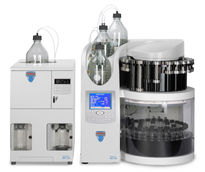U of T technique put to use to test clean up of contaminated groundwater
Cleaning up the dangerous contaminants — dry-cleaning fluids, solvents and petroleum hydrocarbons — found in underground water presents one of the most urgent challenges facing environmental science. A report issued by the U.S. Environmental Protection Agency (EPA) sheds light on a new way to monitor and improve the success of clean-up efforts using a technique developed at the University of Toronto.
"The most common method to clean-up groundwater is biodegradation — using microbes to consume the contaminants and break them down into more benign end products that are not harmful to the environment," says U of T geochemist Barbara Sherwood Lollar, the scientist who initiated the concept and goals for the EPA report and is one of its five international authors.
The report outlines how this can be done using a novel technique called Compound Specific Isotope Analysis, developed in U of T's Stable Isotope Laboratory. The elements of carbon that form the basis for the hydrocarbon contaminants actually come in two types called isotopes, explains Sherwood Lollar. "When microbes degrade contaminants, they prefer the lighter isotope carbon 12 over the heavier isotope carbon 13. The resulting change in the ratio of these isotopes in the contaminant itself is a dramatic and definitive indicator that the biodegradation is successfully taking place."
Beginning in the 1990s, U of T's Stable Isotope Laboratory has been an international pioneer in discovering how different carbon isotopes can be used to identify whether or not biodegradation is taking place. "Today, dozens of students in Canada have been trained in this method, drawn in by the fascinating combination of fundamental research that has important applications such as the clean-up of drinking water," says Sherwood Lollar. Over the past decade, as the new technique has become more widespread, centres for research and education —- and even private companies — have blossomed worldwide.
Most read news
Topics
Organizations
Other news from the department science
These products might interest you

ERBAdry by CARLO ERBA Reagents
Anhydrous solvents from CARLO ERBA Reagents in a clever redesign
ERBAdry series impresses with the latest generation of septa and sealing caps

Thermo Scientific™ Dionex™ ASE™ 150 or 350 Accelerated Solvent Extractor systems by Thermo Fisher Scientific
Accelerated Solvent Extraction (ASE) – Maximize results and reduce errors in food analysis!
More extractions in less time using less solvent

Get the chemical industry in your inbox
By submitting this form you agree that LUMITOS AG will send you the newsletter(s) selected above by email. Your data will not be passed on to third parties. Your data will be stored and processed in accordance with our data protection regulations. LUMITOS may contact you by email for the purpose of advertising or market and opinion surveys. You can revoke your consent at any time without giving reasons to LUMITOS AG, Ernst-Augustin-Str. 2, 12489 Berlin, Germany or by e-mail at revoke@lumitos.com with effect for the future. In addition, each email contains a link to unsubscribe from the corresponding newsletter.





























































